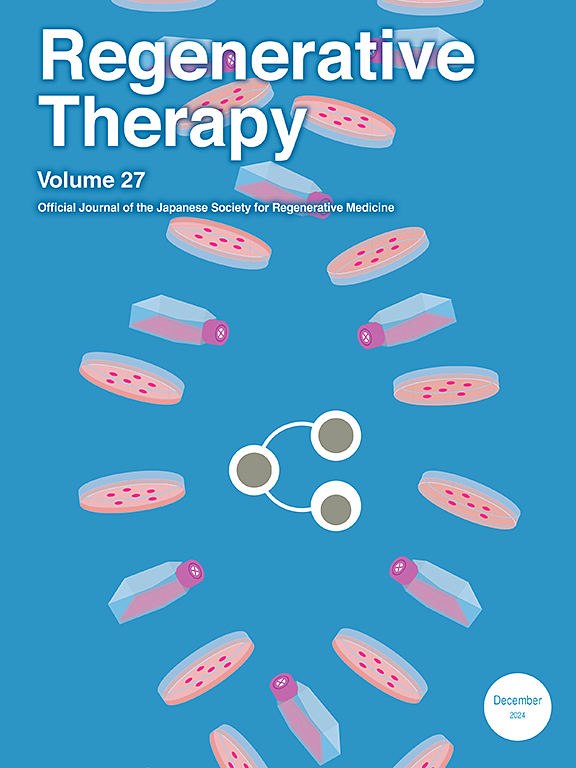Mesenchymal stem cells: A new strategy for the treatment of femoral head necrosis
IF 3.5
3区 环境科学与生态学
Q3 CELL & TISSUE ENGINEERING
引用次数: 0
Abstract
Avascular necrosis of the femoral head (AVFH) is an orthopaedic disease triggered by ischaemic injury that is characterized by structural destruction of the femoral head and loss of function and severely affects the quality of life of patients. Currently, core decompression, bone grafting with vascularized tips, and artificial hip replacement are the main surgical treatment options used in clinical practice; however, these methods generally have limitations, such as trauma, high cost, and long postoperative recovery periods, which impose significant physiological and economic burdens on patients. In recent years, mesenchymal stem cells (MSCs) have shown great potential in the field of bone tissue engineering because of their unique biological properties. MSCs can self-renew and undergo multidirectional differentiation into osteoblasts, chondrocytes, and endothelial cells, and can also regulate the local microenvironment and promote the vascularization of the hip through the secretion of biologically active substances. MSCs can regulate the local microenvironment and promote new blood vessel and bone tissue regeneration through the secretion of growth factors, cytokines, and exosomes. The advantages of MSCs, such as easy access to materials, strong proliferation ability in vitro and stable osteogenic differentiation potential, make them ideal seed cells for femoral head necrosis treatment. However, ANFH treatment with MSCs faces many challenges: (1) the number of MSCs homing to lesion areas after intravenous infusion is limited; (2) the survival time and biological behaviour of locally injected MSCs are still unclear; (3) the mechanism of the interaction between MSCs and host cells has yet to be elucidated; and (4) efficiently modulating the microenvironment of necrotic areas for tissue regeneration needs to be investigated in depth. There are various innovative strategies to address these issues: enhancing the homing ability and in vivo stability of MSCs through genetic engineering; combining MSCs with biomaterials, such as hydrogels, to achieve precise targeting and slow release; and developing drug delivery systems for MSCs to improve therapeutic efficacy. In this paper, we systematically reviewed the pathological microenvironmental characteristics of femoral head necrosis and discuss the potential application, mechanism, existing problems, and solutions of MSCs in ANFH treatment in detail, providing a new theoretical basis and research direction for advancing the clinical treatment of femoral head necrosis.
间充质干细胞:治疗股骨头坏死的新策略
股骨头缺血性坏死(AVFH)是一种以股骨头结构破坏和功能丧失为特征的缺血性损伤引发的骨科疾病,严重影响患者的生活质量。目前,核心减压、带血管尖端骨移植和人工髋关节置换术是临床应用的主要手术治疗方案;然而,这些方法普遍存在创伤性、费用高、术后恢复期长等局限性,给患者带来了较大的生理和经济负担。近年来,间充质干细胞(MSCs)因其独特的生物学特性在骨组织工程领域显示出巨大的潜力。MSCs可以自我更新并多向分化为成骨细胞、软骨细胞和内皮细胞,还可以通过分泌生物活性物质调节局部微环境,促进髋关节血管化。MSCs通过分泌生长因子、细胞因子和外泌体调节局部微环境,促进新生血管和骨组织再生。MSCs易获得材料、体外增殖能力强、成骨分化潜力稳定等优点,使其成为治疗股骨头坏死的理想种子细胞。然而,用MSCs治疗ANFH面临着许多挑战:(1)静脉输注后归家到病变区域的MSCs数量有限;(2)局部注射MSCs的存活时间和生物学行为尚不清楚;(3) MSCs与宿主细胞相互作用的机制尚未阐明;(4)有效调节坏死区域的微环境以促进组织再生需要深入研究。有各种创新策略来解决这些问题:通过基因工程增强间充质干细胞的归巢能力和体内稳定性;将MSCs与水凝胶等生物材料结合,实现精准靶向和缓释;以及开发骨髓间充质干细胞的药物输送系统以提高治疗效果。本文系统综述了股骨头坏死的病理微环境特征,详细探讨了MSCs在ANFH治疗中的潜在应用、机制、存在问题及解决方案,为推进股骨头坏死的临床治疗提供了新的理论基础和研究方向。
本文章由计算机程序翻译,如有差异,请以英文原文为准。
求助全文
约1分钟内获得全文
求助全文
来源期刊

Regenerative Therapy
Engineering-Biomedical Engineering
CiteScore
6.00
自引率
2.30%
发文量
106
审稿时长
49 days
期刊介绍:
Regenerative Therapy is the official peer-reviewed online journal of the Japanese Society for Regenerative Medicine.
Regenerative Therapy is a multidisciplinary journal that publishes original articles and reviews of basic research, clinical translation, industrial development, and regulatory issues focusing on stem cell biology, tissue engineering, and regenerative medicine.
 求助内容:
求助内容: 应助结果提醒方式:
应助结果提醒方式:


